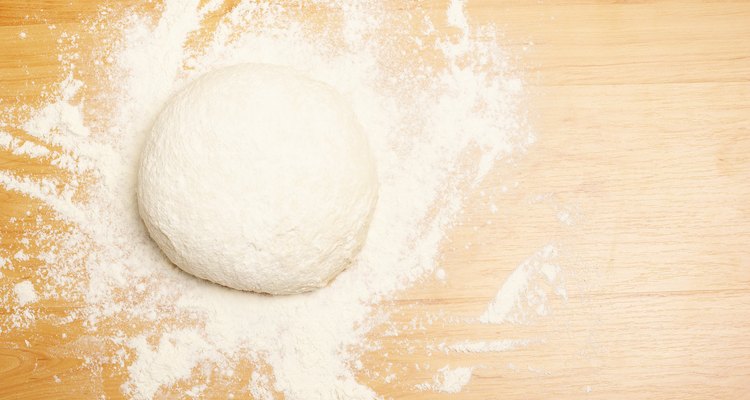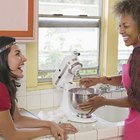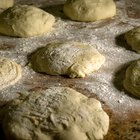
A standing mixer may make fast work of kneading, but it's not the only way to get the job done. You can use hand kneading and several other techniques to combine and knead the ingredients for dough even if a recipe specifically recommends using a standing mixer. Once you understand several different kneading methods, you will be able to tailor your dough-making journey to your needs, time constraints and personal preferences.
The Need to Knead

When you make bread, pasta or certain other types of baked goods, you will be instructed to knead the dough until it comes together. The purpose of kneading is to warm and stretch the gluten that is developing in your dough. Typically, you knead your dough until it's smooth, cohesive and "springy."
The Best Method for You
A stand mixer is usually the fastest, most efficient way to bring together and work your dough. Unlike your hands, the mixer doesn't get tired and will maintain the same pace without pause until the work is done. Furthermore, you won't have to deal with a dirty counter top. If you're looking for a method that's quick, simple and low-mess, a stand mixer is the way to go.
The best thing about hand kneading your dough is that if you don't already have a stand mixer, you won't have to invest hundreds of dollars in equipment. Hand kneading also offers more control over your dough and a great arm workout. Any recipe that calls for a stand mixer can be successfully completed by hand. It just might take you a bit longer, require a little more muscle and be slightly messier.
Kneading With a Standing Mixer

To get started, attach the dough hook to your mixer. Add the ingredients in the order the recipe specifies and then select the recommended speed. Usually, you will start out on a low speed to combine and progress to a medium speed for the kneading stage.
Check on your dough every few minutes until the allotted kneading time recommended by your recipe is up. Usually, a stand mixer will take about five minutes to complete the kneading. At this point, you may have to work the dough over once or twice with your hands to ensure that it has a nice round shape. Your dough is now ready to rise according to the time and conditions your recipe recommends.
Kneading By Hand
Start by adding your ingredients to a large bowl in the order your recipe specifies. You can use a wooden spoon or plastic spatula to mix the ingredients while they are still fairly wet. Continue spinning the bowl with one hand in quarter turns while swiping the side of the bowl and folding the ingredients over each other.
Once the ingredients are mixed into a shaggy dough, you can turn your dough onto a lightly floured counter top. With lightly floured hands, work the dough by folding it over itself and pressing it down with the heels of your hands, turning it 90 degrees with each fold until it is a smooth, springy ball. Hand kneading usually takes up to 10 minutes to complete, about twice as the standing mixer method.
Kneading Tips and Tricks
While hand mixers or food processors aren't capable of kneading dough, they can combine your dough ingredients, saving you time and ensuring a more fully integrated dough to knead. You can also use a bread machine to complete the entire dough-making process. Alternatively, buy "no-knead" bread dough, which eliminates the hassles of kneading altogether.
Related Articles
How Long to Knead Bread Dough by Hand?

How to Make Pizza Shop Quality Pizza ...

Does Hand Mixing Cakes Make Them More ...

How to Make Light Airy Italian Bread ...

How to Cook Dumplings in the Crockpot

How to Make Bread Rise Indoors

How to Make Dough in a KitchenAid Mixer

How to Make Homemade Traditional Polish ...

How Long Do You Have to Mix the Flour ...

How to Make Vanilla Ice Cream With ...

Can Fast Acting Yeast Be Used in Place ...

Do You Use a Wire Whip or Flat Beater ...

Will My Dumplings Get More Airy As They ...
Can You Make a Pie Shell Using Pancake ...

How to Use a Bread Machine to Make Dough

How to Make Dinner Rolls With a ...

How to Make Elastic Pizza Dough So You ...

Can I Make Chapati Dough in Advance?

How to Mix Whipped Cream Cheese & ...

How Does a Bread Maker Work?
References
Resources
Writer Bio
Maya Silver is an editor at DiningOut Magazines. She is the author of "My Parent Has Cancer And It Really Sucks" and has written for "U.S. News & World Report," the "Washington Post Express" and local newspapers and magazines. She has helped hundreds of homes make energy improvements. Her culinary knowledge stems from professional and personal cooking experience.
Photo Credits
Jupiterimages/BananaStock/Getty Images